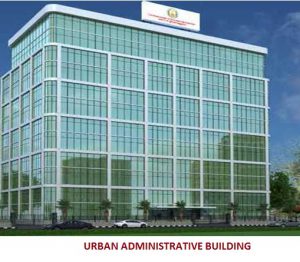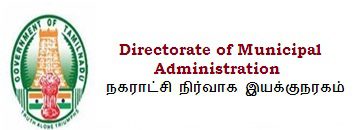The Directorate of Municipal Administration is the nodal department responsible for coordinating and supervising the functions of all Municipalities and Municipal Corporations in the State except the Corporation of Chennai. The Directorate of Municipal Administration is headed by the Director of Municipal Administration and assisted by Joint Commissioner, Additional Directors, Joint Directors and 7 Regional Directors of Municipal Administration (one each for Chengalpattu, Vellore, Salem, Tiruppur, Thanjavur, Madurai and Tirunelveli regions.
 The population of the Corporations (except Chennai Corporation) as per census 2011, is 80,65,843 accounting for 11.18% of the total population of the State and 23.08% of the Urban population and the annual growth rate is 1.10%. The total area under the Corporations (except Chennai Corporation) is 1278.34 sq.km. which constitutes 9.38 % of the total urban area of the State.
The population of the Corporations (except Chennai Corporation) as per census 2011, is 80,65,843 accounting for 11.18% of the total population of the State and 23.08% of the Urban population and the annual growth rate is 1.10%. The total area under the Corporations (except Chennai Corporation) is 1278.34 sq.km. which constitutes 9.38 % of the total urban area of the State.
The population of the Municipalities as per census 2011, is 90,18,646 accounting for 12.50% of the total population of the State and 25.80% of the urban population and the annual growth rate is 1.02%. The total area under the Municipalities is 2560.12 sq.km. which constitutes 18.78 % of the total urban area of the State.
There are 20 Municipal Corporations (except Chennai) viz, Madurai, Coimbatore, Tiruchirappalli, Tirunelveli, Salem, Tiruppur, Erode, Vellore, Thoothukudi, Dindigul, Thanjavur,Nagarcoil, Hosur, Avadi Kancheepuram,Karur, Cuddalore, Tambaram, Kumbakonam, Sivakasi and 138 Municipalities under the administrative control of the Directorate of Municipal Administration. The Municipalities in the State have been classified into different grades based on their annual income as follows:
| Sl. No | Grade | Annual income | No. of Municipalities |
| (in Rs. crore) | |||
| 1 | Special Grade | Above 10.00 | 16 |
| 2 | Selection Grade | 6.00-10.00 | 29 |
| 3 | First Grade | 4.00-6.00 | 31 |
| 4 | Second Grade | Below 4.00 | 62 |
| Total | 138 |
History of Municipal Administration
Municipal Administration has a long history in Tamil Nadu. In South India, the celebrated “Kudavolai” system of imperial Cholas, points to the existence of well-organized representative institutions. They were basic grassroot democratic bodies.
The History of local self-governance in urban areas has the following highlights:

Constitutional Amendment:
A new section relating to the Urban Local Bodies in the Constitution of India was added in 1992 to provide for
- Constitution of three types of Municipalities:
- Nagar Panchayat, for areas in transition from rural to urban area (Town Panchayats)
- Municipal Council for smaller urban area
- Municipal Corporation for larger urban area
- Composition of Municipal Councils
- Representation of Chairpersons of Committees, if any, at the ward or other levels in the Municipalities
- Representation of MLA/MP representing the constituency within which the ULB is situated
- Election of Chairperson of a Municipality in the manner specified by the State Law
- Constitution of committees at ward level or other level within the municipal area as may be provided in the State Law
- Reservation of seats in municipal councils both in the offices of Councilors and chairman :
- For Scheduled Castes and Scheduled Tribes
- For Women
- In favour of backward class of citizens
Fixed term of office for five years
Levy of taxes and duties by Municipalities, assigning the proceeds of tax and duties to Municipalities by the State Government and for making grants
Constitution of State Finance Commission to review the finances of Municipalities
Audit of accounts
Constitution of State Election Commission for the conduct of elections to all Local Bodies
Constitutional Amendments
The proposal to amend the Constitution by adding a separate Part, culminated in the passing of the Constitution (74th Amendment) Act, 1992. The amendments relating to Urban Bodies have been incorporated as Part IX-A of the Constitution. It contains 17 Articles, namely 243 P to 243 ZG. The Constitution (74th Amendment) Act, 1992 as per the Article 243-W endows the Municipalities such powers, authority and responsibilities to function as institutions of self-government in relation to the matters listed below as in the Twelfth Schedule :-
Twelfth Schedule
- Urban planning including town planning
- Regulation of land use and construction of buildings
- Planning for economic and social development
- Roads and bridges
- Water supply for domestic, industrial and commercial purposes
- Public health, sanitation conservancy and solid waste management
- Fire services
- Urban forestry, protection of the environment and promotion of ecological aspects
- Safeguarding the interests of weaker sections of society, including the handicapped and mentally retarded
- Slum improvement and upgradation
- Urban poverty alleviation
- Provision of urban amenities and facilities such as parks, gardens, playgrounds
- Promotion of cultural, educational and aesthetic aspects
- Burials and burial grounds; cremations, cremation grounds and electric crematoriums
- Cattle pounds; prevention of cruelty to animals
- Vital statistics including registration of births and deaths
- Public amenities including street lighting, parking lots, bus stops and public conveniences
- Regulation of slaughter houses and tanneries
